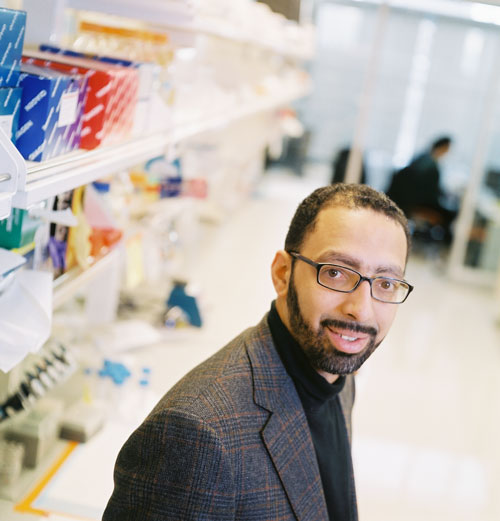Although we now have the ability to sequence entire genomes, doing so is expensive and time-consuming. The HapMap project has made it more feasible to study genetic differences among individuals, creating a CliffsNotes version of the genome that hits the key sites where people differ while skimming over the details. A new technique aims to do the same for cancer genomics. Recent studies have begun to characterize the genetic aberrations in a wide range of tumor types, unearthing a great deal of potential targets for therapy. But translating those findings into the clinic requires a different approach.

In a paper published in the March Nature Genetics, a team led by Levi Garraway, HMS instructor in medicine at Dana–Farber Cancer Institute, demonstrates a technique that creates a quick study guide for cancer. The technique, which involves analyzing tumor samples for known mutations in oncogenes, could be used to gather information about a wide range of tumors and to support the use of emerging targeted therapies in patients.
The Devil You KnowDespite a growing body of knowledge about genetic changes involved in cancer, Garraway said that a practical question still remains: “How do you elicit the relevant genetic alterations in a tumor from a given patient who walks in the door?” The first priority, he said, is to “figure out what has gone wrong in this cancer that we can target.” Since studying the entire genome is difficult, Garraway believes it makes more sense to focus initially on the cancer-causing events that scientists already know about.
Although science has uncovered hundreds of mutations in oncogenes that lead to cancer, they are not found randomly dispersed throughout the genes. For instance, in the well-studied oncogene Ras, “there are only three amino-acid changes in the entire gene that account for nearly all the known Ras mutations in cancer,” Garraway said. So it is possible to test for known mutations in oncogenes by examining only a tiny fraction of the entire genome—covering the landmarks instead of the entire territory.
The Nature Genetics paper offers a proof of principle for this approach. Garraway’s team, which included first authors Roman Thomas, Alissa Baker, and Ralph DeBiasi, and a collaboration with Matthew Meyerson, HMS associate professor of pathology at DFCI, created assays for 238 known mutations found in 17 human oncogenes. The DNA from 1,000 tumor samples collected at a variety of institutions was analyzed for mutations using mass spectrometry, which can detect point mutations in small pieces of DNA using the predicted mass corresponding to the bases examined. Advantages of the method include its low cost and sensitivity—it can detect a variant base present in the sample at a level of 10 percent or less. Garraway said that sensitivity is important since many tumor samples contain a heterogeneous mix of tissue, only part of which may be cancerous.
Crossover TreatmentWhile this approach has been used previously to analyze specific mutations, this study is the first time it has been applied in such a systematic way, cataloging many different mutations across multiple cancer types. The analysis confirmed some expected findings. The team found, for instance, that certain mutations are frequent in certain tumor types, like BRAF in melanoma. But there were also surprises. Mutations in BRAF, for example, were found at low frequency in four other cancer types. Garraway said such information might be important because as targeted therapies emerge, a small number of patients may harbor “druggable” mutations even if they do not have the type of cancer the drug was developed for. An analysis like this could reveal such opportunities.
The team also found an unexpectedly large frequency of mutations that occur together in the same sample, some of which are in the same pathways. Such information could reveal instances when blocking a single oncogene is probably not effective.
Although Garraway said this technique is not a discovery tool, since it cannot identify new aberrations in cancer genomes, it does give scientists a clearer picture of the prevalence of mutations across cancers. The results also demonstrate the daunting task facing cancer genomics. In this study, three genes had no mutations in the samples, and the other 14 genes were found to be mutated in only 30 percent of samples, leaving a lot of territory uncovered.

Stephen Chanock, senior investigator at the National Cancer Institute, said that the study is sobering because it shows that some of the best-characterized mutations do not occur very commonly and that tumors are highly diverse. The hunt for therapies will have many targets to chase. “It’s telling us in glaring terms that this is going to be a long and complicated process to investigate the common and unique features of different types of cancers,” he said. Finding patterns in the mutations across cancers will be difficult, but this study opens the door for future studies that examine more genetic changes across more samples. “It’s going to take a large number of tumors and a large number of individuals to really make sense of this,” he said.
Garraway said his next step is to create a version that includes more than a thousand assays for mutations in 90 different genes. The cost of the technology—less than $100 per sample in this analysis, but more for a more comprehensive scan—is within reason for clinical use. Part of the challenge of making this technique widely usable, however, is developing software to collect and analyze data from the assays. Currently, the technique can look only for mutations that switch on oncogenes, not those that turn off tumor suppressors; the first approach is more manageable since fewer ways exist to switch genes on than to turn them off. The method also misses other genomic events, like amplifications and deletions of DNA. But Garraway hopes that the basic concept can be tweaked to make it possible to study efficiently a range of genomic events in cancer.


